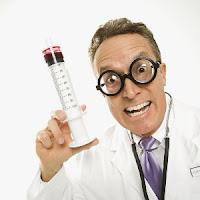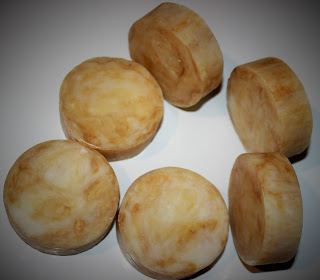There is a lot of good information on natural soap
products but this blog will consolidate the information I would have liked to
find in one place.
Check my October post for Natural Soap Making Instructions
I wanted products that were effective, cheap, healthy and
simple. I do compromise sometimes.
For first time soap makers, soap is made by dissolving Lye or Caustic Soda (Sodium Hydroxide) in water and using a stick blender to mix it into
particular oils. The chemical reaction causes
it to thicken as you blend, till you can see dribble marks across the surface
of the soap batter.
This is called “
trace” and is the time you add things such as essential oils,
honey, oats and pour into your mould. This is the “
cold process” but to speed
everything up you can cook it at this stage (
Hot Process) in a double boiler or slow cooker
for an hour or less. Test the pH to
check it is not too alkaline (a sign of excess lye) – about 8-9.5pH is good. Over 10pH will be stingy.
When making a honey soap, discount your water for the lye mixture to at least 33%. Mix the honey into a little water so it stirs in more evenly. I have had honey settle to the bottom of the soap because the batter was too "thin".
Fumes from the lye mix vary depending on what you are mixing it into. I have never had a problem with ice milk. Have good ventilation when mixing in water. I have heard that mixing it into carrot juice produces a lot of fumes.
Cold process soap needs to be moulded till it is solid (
24 hours or less). It will heat up in
the mould and gel. You can encourage this by covering with towels. This will make it a little darker or add
vibrancy to colours. Keeping it cool
stops the gel stage and results in a lighter coloured soap. There is no difference in the quality. Milk or honey soaps need to be kept cool (refrigerate
or even freeze) while moulded or they could erupt. This applies to any added ingredient that has sugars (natural) in it.
Cold process soap takes longer for the pH to drop (let it
cure for at least 4 weeks) but hot process can be used straight away, though
drying will harden it further causing it to last longer.
Covering with plastic wrap will prevent soda ash from forming on the surface of the soap. Soda ash is only a cosmetic problem and can
be wiped off with a damp cloth if you can be bothered.
Test with pH strips or the zap test. This is a quick lick. Excess lye will zap you
and you definitely will know.
All the lye and oils (except for a percentage of free oil
called a “Superfat”) are used up to create a glycerine based solid soap. A superfat of 5% is commonly allowed to
condition the skin and to make sure all the lye is “moped” up.
Lye obviously is very caustic and
safety precautions are
important to avoid burns. Gloves and glasses are a must. Vinegar being an acid
neutralises the alkaline lye and is your first aid for splashes on the skin. It will also pit concrete if it splashes on a concrete floor. Once again use vinegar to neutralise
The longer you dry your soap the harder it will become,
reducing wastage.
I am not sure on shelf life of soap. Castile soap can dry for 12 months before use
and probably lasts a lot longer. Someone
had an 80 year old coconut oil soap. Some
oils do last longer than other and I have heard that canola is poor… but really,
why use canola at all for anything. There
are probably a lot of variables, such as oils used and average temperature.
Using milk in place of water be it goat or cow, to
dissolve the lye makes a nicer soap with more bubbles. To
prevent it overheating, use the milk frozen to at least a slushy consistency
and double bowl in ice water. While it
is cold it will remain white but as it heats will become increasingly
orange. This will fade. Some people use
a 50% milk/water mix. Adding the lye
very slowly helps. I like to have my milk more towards a solid ice (ice cubes are best) which melts as the lye reaction starts working. Make sure the lye is well mixed. If it stays icy the lye may not dissolve and you will end up with lye spots in your soap. Let is melt a bit more before continuing. The oils should not be too hot either.
Essential oils in soap do have an effect on the skin even
though a percentage is washed down the drain.
Honey is good for everything (ratio of about 3 Tble Sp. Per 1000gm oil). Honey and other sugars increase bubbles.
Spices such as turmeric not only colour soap but are very good for your skin. It will be quite an orange colour as you mix your soap batter but will begin to fade in the mould.
A strained
Paprika infusion will colour you soap bright orange.
Spirulina will create very nice green coloured soap but will fade quite quickly.
I have read that
Beetroot juice will turn an unpleasant brown.. Not sure if this is the chemical reaction or the heat.
While
fragrances are said to be safe, there are no lists of ingredients for you to check. Perfumers have secrecy rights and not everyone has your best interest at heart. Having said that I do think there is a place for fragrances. One of my children just wont use my essential oil soaps and body washes. So I make Watermelon and Green Apple natural liquid soap body wash. I has to be better than what she would otherwise buy.
Clays are often used, either for colour or adding slip to a shaving soap, or for skin care.
You can do
herbal infusions in your oil to add to the benefits. Try growing your own, drying them and using
herbs such as Oregano, Rosemary, Lemon Grass.
The oil will end up a little darker.
Vitamin E helps slow oils in soap from going rancid and
is good for skin. Use about 4 drops per 1000gm of oil.
Sweating soap is from high humidity. This was worse when trying to cure new soap
on a hot humid day. It is the sign of a good soap and can be improved by
putting the soap under lights. I didn’t
try a fan but that may help.
The main thing about a Shampoo bar is the lather but I have found many internet recipes to be very soft. I don't like this. If you prefer a harder bar, look at my shaving soap recipe. Don’t use a bar with oats or
“bits” in it unless you are happy to have that in your hair. You could make oat milk and fine strain it. Decrease the superfat for oily hair and increase it for dry hair. A milk soap is nice for this. Natural
liquid soap is more convenient - like a shampoo but bar soap is a very convenient one stop shop when travelling.
I haven’t been able to find any specific requirements for
a pet soap. Dogs have higher skin pH
than humans, so the alkalinity is no problem.
I made a bar soap with a lower cleaning characteristic and an increased
superfat to reduce drying the skin, with a higher castor oil content for
lather. I would just use the shaving soap recipe I have. Essential oils can be used for dogs but not
cats. Natural liquid soap will have an
advantage in that you can have high conditioning, increase the lather and keep
the cleaning characteristic a lot lower. Make sure it has a super fat
Use a potato peeler to take off the sharp edges and the
soap will feel nicer when you use it.
Save all your soap remains and bits to reheat, melt and
remould for value.
Check recipes taken from the internet on SoapCalc. as
some aren’t as good as others. Too soft,
not enough conditioning etc.
If you do fix your soap and you don't like it or want it because it doesn't look so good, can I suggest you not throw it out but give it to some place like a woman's refuge or to poor people who wouldn't normally get to buy natural soap. I'm sure they wont mind how it looks.
 Magnesium deficiency can also cause you to have worse body odour.
Magnesium deficiency can also cause you to have worse body odour. 




















